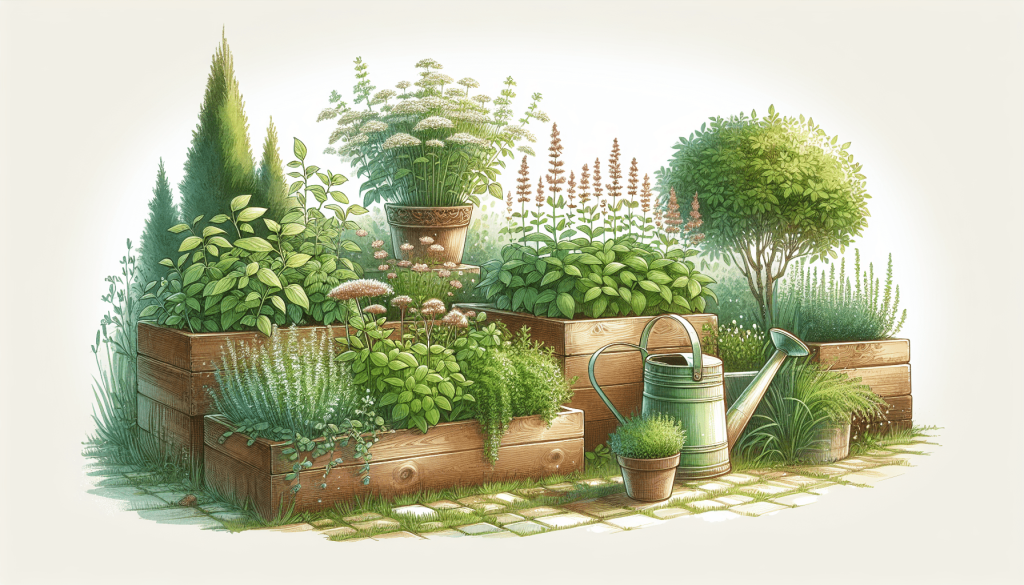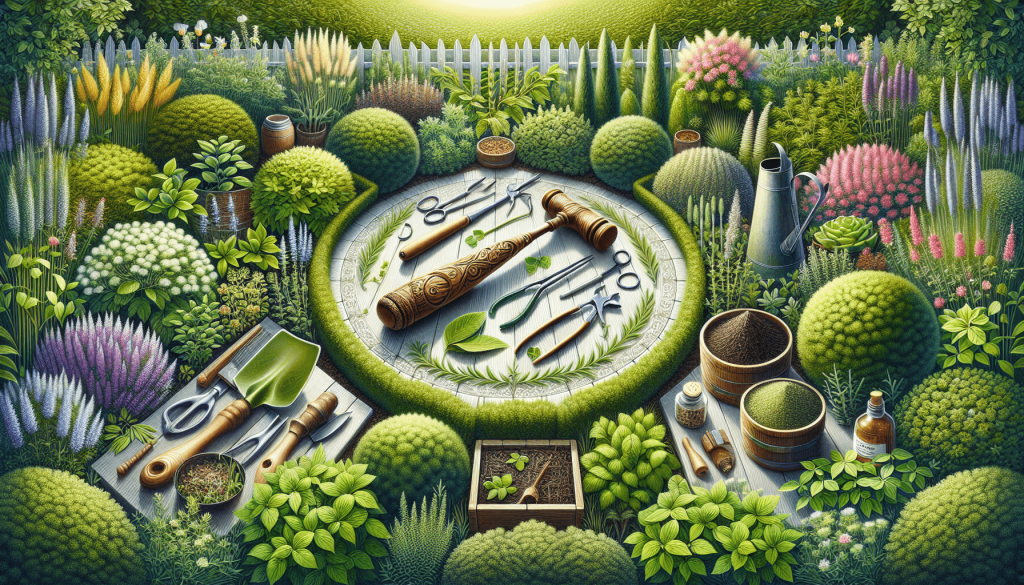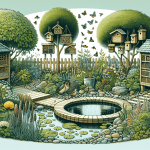This post may contain affiliate links. As an Amazon Associate, we may earn commissions from qualifying purchases.
If you’ve always dreamt of having a beautiful and functional herb garden but have no clue where to start, look no further. In this article, we’ll show you just how simple it can be to turn your backyard or even a small balcony into a thriving herb sanctuary. Whether you’re a seasoned gardener or a complete novice, we’ve got you covered with easy-to-follow tips and tricks, so you’ll be growing your own delicious herbs in no time. Get ready to discover the joy and satisfaction of creating your very own herb garden that not only adds beauty to your space but also enhances your culinary adventures.
Choose the Right Location
Assess the Sun Exposure
When planning your herb garden, it’s essential to choose a location that receives adequate sunlight. Most herbs thrive in full sun, which means they need at least six hours of direct sunlight each day. Take the time to assess the sun exposure in different areas of your yard or balcony to identify the spot that gets the most sunlight. By ensuring that your herbs receive the necessary sunlight, you will promote healthy growth and abundant harvests.
Consider the Soil Quality
The quality of your soil plays a crucial role in the success of your herb garden. Herbs generally prefer well-draining soil with good fertility. Conduct a soil test to determine its composition and pH level. Most herbs prefer a slightly acidic to neutral pH range of 6.0 to 7.0. If needed, amend the soil by adding organic matter, such as compost or aged manure, to improve its texture and fertility. By providing your herbs with the right soil conditions, you can create an optimal growing environment for them to flourish.
Ensure Easy Access for Maintenance
When choosing the location for your herb garden, consider how accessible it will be for maintenance tasks such as watering, harvesting, and pruning. A garden that is conveniently located near your kitchen or outdoor living space makes it easier to step out and pluck some fresh herbs for cooking. Additionally, consider the convenience of a nearby water source for easy watering. By prioritizing easy access, you will make the maintenance of your herb garden a breeze.
Plan the Herb Varieties
Decide on Culinary or Medicinal Herbs
Before you start selecting specific herb varieties, it’s important to determine whether you want to focus on culinary herbs or medicinal herbs. Culinary herbs like basil, mint, and rosemary are commonly used in cooking to enhance flavor. On the other hand, medicinal herbs like chamomile, lavender, and echinacea have various health benefits. Consider your personal preferences and the intended use of the herbs when choosing which types to include in your garden.
Consider Growth Habits and Space Requirements
Different herbs exhibit various growth habits, ranging from compact and bushy to tall and spreading. Take into account the mature size of each herb variety and plan accordingly to accommodate their space requirements. Some herbs, like oregano and thyme, tend to spread and may benefit from planting in containers or dedicated garden beds. By considering the growth habits of your chosen herbs, you can ensure that each plant has enough space to grow and thrive.
Think about Complementary Flavors and Uses
When planning the varieties for your herb garden, think about the flavors and uses that complement each other. For example, if you enjoy cooking Italian cuisine, consider planting basil, oregano, and parsley together. These herbs will work harmoniously to enhance the flavors of your dishes. Similarly, if you’re interested in herbal teas, combining herbs like chamomile, mint, and lemon balm can create delightful and refreshing blends. By selecting herbs with complementary flavors and uses, you can maximize the versatility and enjoyment of your herb garden.

Design and Layout
Select the Garden Style (Formal, Informal, Raised Bed, etc.)
Choosing the right garden style is an exciting part of designing your herb garden. Consider your personal preferences and the overall aesthetic of your outdoor space. Popular herb garden styles include formal, informal, raised bed, and container gardens. Formal gardens feature geometric patterns, symmetrical plantings, and defined edges, creating a structured and elegant look. Informal gardens, on the other hand, have a more relaxed and natural feel, with curved pathways and mixed plantings. Raised bed gardens are suitable for small spaces or areas with poor soil quality, providing better control over the growing conditions. Container gardens offer flexibility, allowing you to place herb plants in decorative pots or hanging baskets.
Map Out the Garden Beds or Containers
Once you’ve selected your garden style, it’s time to map out the garden beds or containers. Use a piece of graph paper or an online garden planning tool to sketch your design. Consider factors such as the available space, the number of herbs you want to grow, and the desired arrangement. Arrange the herbs in a visually pleasing and practical way, making sure to leave enough space for each plant to grow. By mapping out your garden beds or containers, you can create an organized and well-planned herb garden layout.
Incorporate Pathways and Edging
To add functionality and visual interest to your herb garden, incorporate pathways and edging. Pathways not only help you navigate through the garden but also provide an opportunity to showcase decorative materials like stepping stones or gravel. Edging can define the borders of your herb garden and prevent grass or weeds from encroaching. Consider using materials like bricks, stones, or decorative fencing to create a clean and defined edge. By incorporating pathways and edging, you can enhance the overall design and structure of your herb garden.
Consider Companion Planting
Companion planting involves growing different plants together to create mutually beneficial relationships. Certain herbs and vegetables have symbiotic relationships that can enhance growth, repel pests, or improve flavor. For example, planting basil near tomatoes can improve the tomatoes’ flavor and repel pests like aphids. Marigolds planted among your herbs can deter harmful insects. Research companion planting combinations specific to the herbs you’ve selected to maximize their potential benefits. By considering companion planting, you can create a harmonious and productive herb garden.
Organize the Planting
Group by Watering Needs
To simplify your watering routine and conserve water, group your herbs according to their watering needs. Some herbs, like basil and mint, prefer consistently moist soil, while others, such as lavender and rosemary, require drier conditions. By grouping herbs with similar watering requirements together, you can avoid overwatering or underwatering certain plants. This strategy ensures that each herb receives the appropriate amount of water, promoting healthier growth and minimizing water waste.
Arrange by Height and Growth Habit
Arranging your herbs by height and growth habit is not only visually appealing but also practical in terms of plant care and maintenance. Place taller herbs, like dill or fennel, at the back of garden beds or containers to prevent them from shading smaller herbs. Trailing or vining herbs, such as thyme or oregano, can be planted near the edges or allowed to spill over the sides of containers. Bushy or compact herbs, like sage or basil, can be positioned in between, creating a well-balanced and visually pleasing arrangement. By considering the height and growth habit of each herb, you can optimize space and provide proper care for all your plants.
Consider Color Coordination
Color coordination can add visual interest and enhance the beauty of your herb garden. Consider the foliage colors and flower blooms of different herbs when deciding where to place them in your garden. For example, purple basil or lavender will create a stunning contrast when placed near green herbs like parsley or cilantro. Additionally, think about how the colors of your herbs will complement the overall color scheme of your outdoor space. By considering color coordination, you can create an aesthetically pleasing herb garden that is a feast for the eyes.

Planting Techniques
Prepare the Soil and Amend as Needed
Before planting your herbs, it’s important to prepare the soil and amend it as needed. Start by clearing the area of any unwanted weeds or debris. Loosen the soil with a garden fork or tiller, breaking up any compacted areas. If needed, incorporate organic matter like compost or aged manure to improve the soil’s fertility and structure. By preparing the soil properly, you provide a healthy foundation for your herbs to establish and thrive.
Start from Seeds or Purchase Seedlings
When it comes to planting herbs, you have the option to start from seeds or purchase seedlings from a local nursery. Starting from seeds allows you to have a wider selection of herb varieties and can be a rewarding experience. However, it requires more time and patience as you wait for the seeds to germinate and grow into seedlings. If you prefer a quicker start, purchasing seedlings is a convenient option. Whichever method you choose, be sure to follow the planting instructions specific to each herb variety for optimal results.
Space Plants Appropriately
Proper plant spacing is crucial for the health and productivity of your herb garden. Overcrowding can lead to increased competition for nutrients, limited airflow, and higher susceptibility to diseases. Refer to the planting guidelines provided for each herb variety to determine the recommended spacing. Typically, herbs with compact growth habits, such as parsley or chives, can be planted closer together, while herbs with spreading growth habits, such as mint or thyme, require more space. By spacing your plants appropriately, you create an environment that promotes healthy growth and reduces the risk of plant-related issues.
Plant with Care and Water Thoroughly
When it’s time to plant your herbs, handle them with care to avoid damaging their delicate roots or stems. Dig a hole slightly larger than the root ball or seedling, ensuring that the top of the root ball aligns with the soil level. Gently remove the herb from its container, teasing out any circling roots if necessary. Place the herb in the hole and backfill with soil, lightly firming it around the plant. After planting, water the herbs thoroughly to settle the soil and provide immediate hydration. Giving your newly planted herbs a good drink will help them establish quickly, reducing transplant shock and promoting healthy root development.
Provide Adequate Care
Water Regularly and Consistently
Watering is an essential aspect of herb garden care. Most herbs prefer consistently moist soil but not overly saturated conditions. Regular and consistent watering helps keep the soil evenly moist, promoting healthy growth and preventing drought stress. monitor the moisture level by checking the top inch of soil and water when it feels dry to the touch. Avoid overhead watering, as it can lead to leaf diseases. Instead, aim for irrigation at the soil level to minimize water waste and maximize absorption by the roots.
Mulch to Conserve Moisture and Suppress Weeds
One effective way to conserve moisture and suppress weeds is by applying mulch around your herb plants. Organic mulch, such as straw, shredded bark, or compost, helps retain moisture in the soil, reducing the frequency of watering. It also acts as a natural weed suppressant, keeping unwanted plants from competing for resources. Apply a layer of mulch around the base of your herbs, leaving a small gap around the main stem to prevent moisture-related issues. Replenish the mulch as needed to maintain adequate coverage and reap the benefits of reduced watering and weed control.
Fertilize Properly and Prune as Required
Providing your herbs with the necessary nutrients is essential for their overall health and productivity. use a balanced organic fertilizer or compost tea to supplement the soil’s fertility. Apply the fertilizer according to the product instructions, taking care not to overdo it, as excessive fertilizer can lead to imbalanced growth or decreased flavor. Additionally, regular pruning can help maintain the shape and encourage bushier growth. Remove any dead or damaged leaves, stems, or flowers to promote better airflow and minimize the risk of disease. By fertilizing properly and pruning as required, you can ensure that your herbs stay healthy and vibrant.
Monitor and Manage Pests or Diseases
Maintaining a vigilant eye for pests and diseases is an important part of herb garden care. Common pests that may target herbs include aphids, caterpillars, and spider mites. Regularly inspect your herbs for any signs of infestation, such as chewed leaves or sticky residue. If pests are present, consider using organic pest control solutions like neem oil or insecticidal soap. Additionally, keep an eye out for signs of diseases, such as yellowing leaves or fungal growth. Promptly address any disease issues by removing affected plant parts and applying appropriate treatments. By monitoring and managing pests or diseases promptly, you can protect your herb garden from damage and ensure the health of your plants.
Harvesting and Maintenance
Know the Optimal Times for Harvesting
To enjoy the full flavor and medicinal properties of your herbs, it’s important to harvest them at the optimal times. Each herb has its own harvesting guidelines, but a general rule of thumb is to harvest in the morning after the dew has dried, but before the heat of the day. This is when the essential oils and flavors are at their peak. Harvest leaves before the plant flowers, as the flavor can become bitter afterward. Flowers should be harvested at their peak bloom for both culinary and decorative purposes. Read up on the specific harvesting times for your chosen herbs to get the best results.
Trim or Harvest with Precision
When it’s time to harvest your herbs, it’s important to do so with precision to encourage healthy regrowth. Use clean and sharp pruners or scissors to make clean cuts just above a node or leaf joint. Avoid removing more than one-third of the plant’s growth at a time, as it can stress the herb and affect its ability to regenerate. By trimming or harvesting with precision, you promote lush and vigorous growth, ensuring a steady supply of fresh herbs throughout the growing season.
Remove Weeds and Monitor for Diseases
Regular maintenance tasks, such as weeding, are important to keep your herb garden healthy and thriving. Weeds compete with your herbs for nutrients, water, and sunlight, so it’s important to remove them promptly to prevent hindered growth. Regularly inspect your herb plants for any signs of diseases like powdery mildew or leaf spot. Addressing disease issues early on can help prevent the spread and protect the overall health of your herb garden. By removing weeds and monitoring for diseases, you ensure that your herbs have the best growing conditions possible.
Renew or Replace Plants as Needed
In an herb garden, plants may need to be renewed or replaced over time. Some herbs, like basil or parsley, are typically grown as annuals and may need to be replanted each year. Other perennial herbs may become less productive or develop woody stems over time, requiring renewal. Evaluate the health and productivity of your herbs regularly and make the necessary decisions to replace or renew plants as needed. By maintaining a healthy and vigorous herb garden, you can continue to enjoy fresh and flavorful herbs year after year.
Extend the Growing Season
Use Season Extenders like Row Covers or Greenhouses
If you want to extend your herb-growing season, consider using season extenders like row covers or greenhouses. Row covers are lightweight fabric covers that protect plants from cold temperatures, frost, or insect pests while allowing sunlight, air, and water to reach the plants. Greenhouses provide a controlled environment with adjustable temperature and humidity, allowing you to grow herbs year-round. By using season extenders, you can enjoy fresh herbs for an extended period and make the most of your herb garden.
Plant Cold-tolerant Varieties in Fall
For those in colder climates, planting cold-tolerant herb varieties in the fall can help you extend the growing season. Cold-tolerant herbs like thyme, sage, or chives can withstand lower temperatures and continue to grow well into the cooler months. By planting these varieties in the fall, you can enjoy fresh herbs for a longer period before the arrival of winter. Consider covering the plants with row covers or providing additional protection during particularly harsh weather conditions to ensure their survival.
Consider Indoor Herb Gardening
If you have limited outdoor space or live in an area with harsh winters, indoor herb gardening is an excellent option to continue growing herbs throughout the year. Select herbs that are well-suited for indoor conditions, such as mint, chives, or parsley. Place them near a sunny window or use artificial grow lights to provide the necessary light energy for photosynthesis. Ensure proper watering, humidity, and ventilation to create a healthy indoor environment for your herbs. By considering indoor herb gardening, you can enjoy fresh herbs right from the comfort of your own home.
Utilize Vertical Space
Install Trellises, Arbors, or Vertical Planters
If you have limited horizontal space, consider utilizing vertical space in your herb garden. Install trellises, arbors, or vertical planters to grow climbing or vining herbs such as hops or vining rosemary. These structures can provide support for the herbs to grow upward, making efficient use of your available space. Vertical gardening not only maximizes your herb-growing capacity but also adds visual interest and architectural appeal to your garden. By utilizing vertical space, you can create a unique and space-saving herb garden.
Grow Climbing Herbs like Hops or Vining Rosemary
When incorporating vertical gardening into your herb garden, consider growing climbing herbs like hops or vining rosemary. Climbing herbs have the advantage of taking up less ground space while providing a lush and visually striking display. Hops, commonly used in brewing, can create an impressive vertical presence with their twining vines. Vining rosemary adds both practicality and beauty to your garden, as you can enjoy its aromatic foliage and delicate flowers while it gracefully climbs its supporting structure. By growing climbing herbs, you can add dimension and vertical interest to your herb garden.
Add Functional Features
Include a Seating Area or Bench
To fully enjoy your herb garden, consider incorporating a seating area or bench. This addition creates a welcoming space to sit, relax, and savor the sights, scents, and flavors of your herbs. Whether it’s a cozy nook nestled among the herbs or a dedicated garden bench, this functional feature invites you to immerse yourself in the beauty and tranquility of your herb garden. Choose comfortable outdoor furniture and arrange it in a way that allows you to admire and interact with your herbs while enjoying some leisure time.
Integrate Pathway Lighting
Pathway lighting not only adds an element of safety but also enhances the ambiance of your herb garden during nighttime. Integrate low-voltage solar lights or LED light fixtures along the pathways to illuminate the way and create a magical atmosphere. Soft, warm lighting can showcase the foliage and colors of your herbs while allowing you to navigate the garden after dark. Consider using lighting fixtures that blend seamlessly with your garden design, such as discreet solar lights embedded in the ground or decorative lanterns strategically placed along the pathways.
Install Watering Systems
To simplify the watering routine and ensure consistent moisture for your herbs, consider installing a watering system in your garden. Drip irrigation or a soaker hose system can deliver water directly to the base of your plants, minimizing water waste and reducing the risk of leaf diseases. Automating the watering process through a timer or a smart irrigation system can save time, particularly during periods of vacation or unpredictable weather. By installing a watering system, you can provide optimal hydration for your herbs without the hassle of manual watering.
Creating a beautiful and functional herb garden requires thoughtful planning and attention to detail. By selecting the right location, planning the herb varieties, carefully designing the layout, organizing the planting, employing proper planting techniques, providing adequate care, and incorporating additional functional features, you can create a herb garden that is not only visually stunning but also practical and rewarding. So start your herb garden journey today and enjoy the bountiful harvest and aromatic delights that await you!








